Romney Marsh Tokens
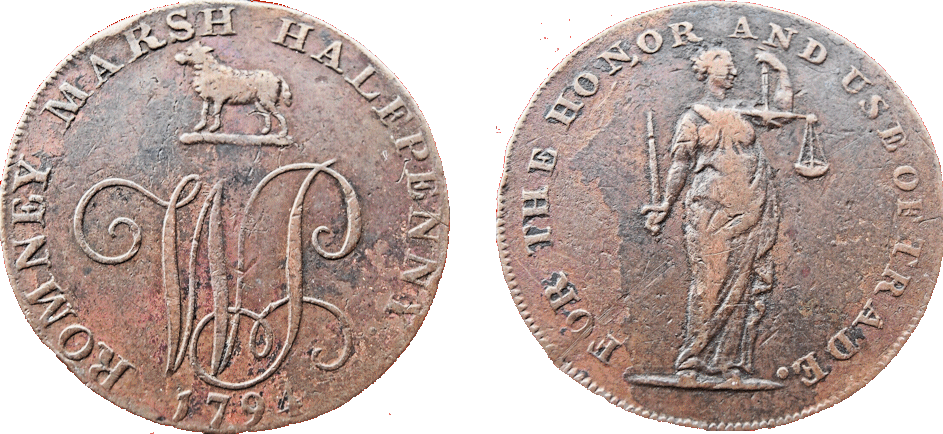
Romney Marsh Halfpenny Token 1794
The coins were made of good weight, that is equal to the crown mint’s legal weight, and guaranteed the redemption (payment) of the tokens in royal money. With this assurance, the tokens were well received by the local populace and beyond.
The driving force behind the need for token coinage was the shortage of small denomination coins for everyday transactions. However, the demand was fueled by other factors such as the Industrial Revolution, population growth, and the preponderance of counterfeit circulating coins. Because the government made little effort to ameliorate this shortage, private business owners and merchants took matters into their own hands, and the first tokens of this type were issued in 1787 to pay workers at the Parys Mine Company. By 1795, millions of tokens of a few thousand varying designs had been struck and were in common use throughout Great Britain.
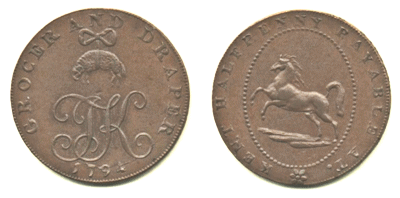
Thomas King, Copper Halfpenney, 1794
General
In Britain, a shortage of small denomination coinage had been reported as early as the late 14th century. Such a shortage made it difficult for workers to be paid, and for transactions of daily life to be carried out.
The shortages persisted and worsened through the late 17th century and became particularly problematic by the middle of the 18th century. The shortage of small denomination coinage reached a critical mass with the move of many workers away from agricultural jobs and into the work force in factories during the Industrial Revolution. The growing payrolls of factories were nearly impossible to meet for employers with no supply of coins.
At the same time, the population growth rate of Great Britain between 1750 and 1800 nearly quadrupled. The situation was only made worse by the outflow of British silver coins via Gresham's law, the preponderance of counterfeit copper coins in circulation, and the Royal Mint's sporadic production of non-gold coins from the late 17th century to the late 18th century. For many years, no copper or silver coins were minted at all, and in 1775 King George III had halted the production of copper coinage at the Royal Mint.
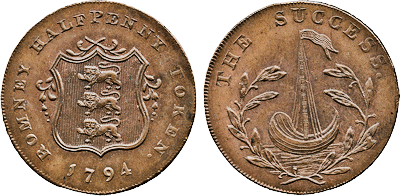
John Sawyer, Copper Halfpenny, 1794
Shield of arms of the town of Romney
Around the perimeter ROMNEY HALFPENNY TOKENS
On reverse A small antique sloop between branches.
Around the perimeter THE SUCCESS
Edge PAYABLE AT IOHN SAWYER'S ROMNEY
John Sawyer was a carpenter and joiner in New Romney
BIn 1768, one of the largest veins of copper in the world was found at Parys Mountain on the island of Anglesey in the northwest of Wales. In 1785, Thomas Williams (the "Copper King"), acting as a representative of the Parys Mine Company, met with the master of the British mint to propose that regal copper coins be struck using a counterfeit-deterrent method of edge lettering, and offering this technology to the mint free of charge.
In February 1787 Williams oversaw the minting of the first of many privately issued copper tokens, some being used to pay workers at the Parys Mine Company. These first tokens bore the image of a hooded Druid, and within two months time were receiving attention in London as a possible solution to the shortage of small denomination coin. Not long after the appearance of the Druid tokens, other cities, businesses, and proprietors would follow suit and begin designing and minting their own small denomination coinage.
Romney Marsh Tokens
In Kent tokens were issued from most of the major towns including Canterbury, Dover, Maidstone, and Tenterden, all bearing the names of local tradespeople. In addition, tokens were issued from much smaller places including the Romney Marsh town of New Romney and the villages of Brookland and Dymchurch.
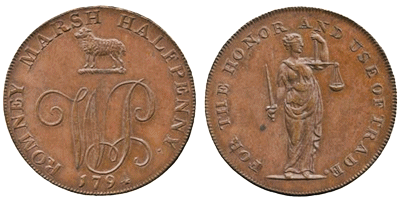
William Paris, Copper Halfpenny, 1794
Cypher W. P., lamb above, 1794 below, ROMNEY MARSH HALFPENNY around, rev figure of Justice standing holding a pair of scales and sword, FOR THE HONOR AND USE OF TRADE around, edge PAYABLE AT W . PARRIS DIMCHURCH
William Parish owned 4 High Street, Dymchurch from 1784 to 1837
One of the attractions of these provincial tokens is the strong local themes employed in the designs. Those from Kent are no exception. The token for Appledore depicts a windmill, those of Canterbury the cathedral, and Padsole Paper Mill is shown on one of the Maidstone tokens. Coins for Romney show a medieval ship and coins from Brookland show the Kentish horse.
The names of local tradespeople responsible for issuing the coins was usually impressed into the rim.
Pictured on the right are three examples of privately issued copper tokens on Romney Marsh, by a traders in Brookland, Dymchurch (spelt Dimchurch on the coin) and New Romney.
By 1802, the production of privately issued provincial tokens had ceased.
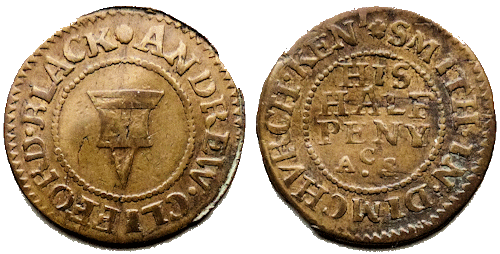
Dymchurch, Andrew Clifford halfpenny
Obv: (rosette)ANDREW.CLIFFORD.BLACK , around beaded inner circle, an anvil.
Rev: (rosette)SMITH.IN.DIMCHVRCH.KENT , around beaded inner circle, HIS HALF PENY in three lines with AC/.S below.
Ex Norweb 2547b, illustrated; ex R. H. Thomson.


